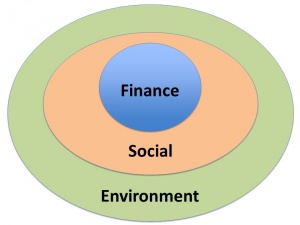Creating sustainable futures/CSF101/Defining sustainability/Model reality
Industrial and economic systems are invariably comprised of many individual players through interwoven and interdependent relationships that form value chains and supply chains that ultimately provide goods and services that are useful for people. Economic systems are essentially a subset of the larger society in which they take place, and intended to deliver social benefits through employment, providing access to goods and services, and improving quality of life.
Social and community systems are comprised of many different groups and individual people who, in democratic countries, are governed by elected representatives. Social systems are made up of people. People are just one species of many on Earth, and their survival is entirely dependent upon the continued function of ecosystems that provide access to food, water and air.
Ecological systems are the interwoven fabric of organisms and ecosystems that form what is often referred to as the natural environment. Ecosystem processes regulate the flux of matter and energy through an environment and are sustained by the variety of living organisms collectively known as biodiversity.
The second way in which the relationship between economic, social and ecological systems are depicted is shown below. This model is sometimes referred to as “strong sustainability” because it reflects the interdependencies of the three systems.
This second model reflects, in a visual form, the hierarchy of the systems: the economy cannot exist without an organised and healthy society. In turn, society cannot exist without a healthy environment that continues to supply basic life-support systems for humans.


